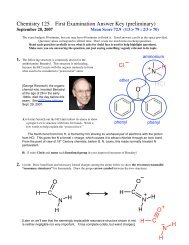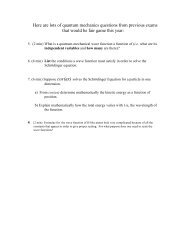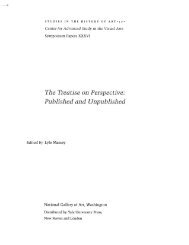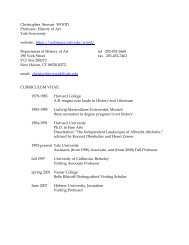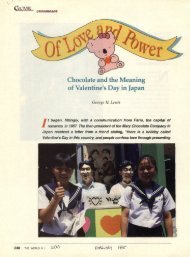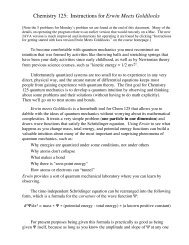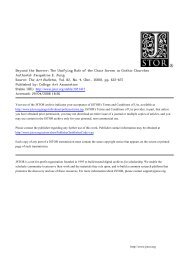Chemistry 125 First Semester Name Final Examination
Chemistry 125 First Semester Name Final Examination
Chemistry 125 First Semester Name Final Examination
- No tags were found...
You also want an ePaper? Increase the reach of your titles
YUMPU automatically turns print PDFs into web optimized ePapers that Google loves.
<strong>Chemistry</strong> <strong>125</strong> <strong>First</strong> <strong>Semester</strong> <strong>Name</strong> ________________December 16, 2005 <strong>Final</strong> <strong>Examination</strong>This exam is budgeted for 150 minutes, but you may have 180 minutes to finish it. Good Luck.1. (52 minutes). ANSWER 13 OF THE FOLLOWING 16 in a blue book. Only the first 13 answers will be graded.Cite experimental evidence that was used to support each of the following chemical principles for the first (or nearly thefirst) time. If the original proposal was hypothetical, cite the experimental evidence that first confirmed it.Answers (4 min each) need not be detailed, just outline the evidence. Where relevant, try to identify the specific moleculesstudied.a) The bond dissociation energy of CO is 257.3 kcal/mole (or maybe 227.3 kcal/mole).b) The heat of atomization of graphite is 171 kcal/mole.c) The atoms in organic molecules are held together by electrical (dualistic) forces.d) The atoms in organic molecules are not held together by electrical forces.e) The van der Waals shape of atoms is not always spherical.f) The substituents in “meta” disubstituted benzenes are on the 1 st and 3 rd atoms of the hexagonal ring.g) The bonds of a tetravalent saturated carbon do not lie in a single plane.h) The bonds from a tetravalent saturated carbon atom make a specific preferred angle.i) Cyclohexane is planar.j) Cyclohexane is not planar.k) The properties of molecules are not solely dependent on the number of atoms of the various elements present.l) Double bonds have elliptical cross sections.m) Carbon is the central atom in methane and holds the four hydrogen atoms to itself.n) Long chain compounds adsorbed on graphite lie flat and as straight and parallel as possible.o) Some bonds do not involve substantial increase in internuclear electron density relative to the component atoms.p) There is a 3 kcal/mole barrier to rotation about the C-C bond in ethane.2. (5 min) Use the relation of wave function shape to potential and total energy to explain why electron energy is sometimesquantized and sometimes not quantized.
Chem <strong>125</strong> <strong>First</strong> <strong>Semester</strong> <strong>Final</strong> Exam 12/16/05 Page 23. (6 min) What key assumption did Boltzmann make in applying statistics to the distribution of energy within a set ofmolecules, and how did it lead to the general shape of the distribution for a single “degree of freedom”?4. (5 min) One may report the energy of a molecule as heat of combustion, as heat of formation, or as heat of atomization.Explain which of these is best suited for developing a simple, practical scheme for relating energy to structural theory.5. (8 min) Use the following heats of formation to establish strain energies for the five compounds:H f (kcal/mole)cyclopropane +13cyclobutane +7cyclopentane -20cyclohexane -30cycloheptane -28
Chem <strong>125</strong> <strong>First</strong> <strong>Semester</strong> <strong>Final</strong> Exam 12/16/05 Page 36. (5 min) Explain how cyclohexane distorts from idealized angles in order to minimize its energy. Repeat for one of the othermolecules in the previous question.7. (5 min) Explain how it is that “correlation energy” and “strain energy” may be considered to be analogous concepts.8. A) (4 min) Draw accurate structures for axial and equatorial methylcyclohexane in the chair conformation.AxialEquatorialB) (3 min) Use your drawings in part A to illustrate a pair of atoms that are homotopic (H), a pair that are enantiotopic (E),and a pair that are diastereotopic (D), all in terms of configuration. (Draw three lines connecting the pairs, label H,E,D)C) (5 min) Use your knowledge of the conformational energy of butane to estimate a numerical equilibrium constantbetween axial and equatorial methylcyclohexane. Explain your thinking briefly.
Chem <strong>125</strong> <strong>First</strong> <strong>Semester</strong> <strong>Final</strong> Exam 12/16/05 Page 49. (7 min) Draw a Fischer projection and a Newman projection for each of the following two isomers of tartaric(1R,2R) tartaric acidmesotartaric acidFischerNewman10. (4 min) In terms of the mechanism of pharmacological action of the proton pump inhibitor omeprazole, what was the reasonfor AstraZeneca to worry that a “chiral switch” to enhance potency would not be successful?11. (6 min) Briefly describe the three different methods AstraZeneca used to prepare esomeprazole as a single enantiomer.
Chem <strong>125</strong> <strong>First</strong> <strong>Semester</strong> <strong>Final</strong> Exam 12/16/05 Page 512. (2 min) <strong>Name</strong> the functional group in each of the following molecules (I-IV, which are the subjects of Questions 12-16)ROH RC R NH 2 C N R CHRI II III IVONH 213. (6 min) Identify the HOMOs and LUMOs of I-III above, and explain why each is particularly high or low energy.I II IIIHOMOLUMO14. (5 min) Use curved arrows to show how molecule I could react with molecule II to give an “aminol” (both an alcohol and anamine). Several steps are necessary.
Chem <strong>125</strong> <strong>First</strong> <strong>Semester</strong> <strong>Final</strong> Exam 12/16/05 Page 615. (5 min) Use curved arrows to show how the aminol product of the previous question could give molecule III.16. A) (1 min) Explain why molecule III is more easily protonated (more basic) than molecule I.B) (6 min) Explain why, despite the above, molecule IV is preferentially protonated on its oxygen atom rather than onits nitrogen, and how this property is related to the resistance to rotation about the C-N bond in molecule IV in itsunprotonated and protonated forms.
Chem <strong>125</strong> <strong>First</strong> <strong>Semester</strong> <strong>Final</strong> Exam 12/16/05 Page 717. A novel experimental technique reveals the shape and relative signs of theHOMO of the N 2 molecule. The figure on the right shows a slice through thisHOMO as measured experimentally in this way.To interpret the Å scale, NOTE that the N-N distance in N 2 is 1.09Å[The original figure is colored with the dark central blob shades of blue and the flanking “eyes”shades of red to denote opposite signs of the wave function. The lighter surrounding features areprobably insignificant beacause of experimental error.]The lower graph, with the same horizontal scale, plots the MO wavefunction along the Y = 0 line of the upper graph. The dashed line isexperimental, and the solid line is the result of an MO calculation.A) (4 min) Why cannot x-ray diffraction provide a similar graph showing theshape and signs of the HOMO? (Give two reasons, but ignore the difficulty ofpreparing a crystal of N 2 ).B) (2 min) Explain which atomic orbitals of nitrogen seem to dominate in making up this MO?C) (4 min) At the extremes of the lower plot, the calculated (solid) wave function seems to approach =0 exponentially, whilethe experimental (dashed) curve has extra wiggles. Explain which behavior makes more sense in terms of reasonablekinetic and potential energy for an electron in this molecule.d) (4 min) Given this shape of the HOMO, explain where in the top figure you would expect H + to add to N 2 , and whetherprotonation should make the N–N distance longer or shorter.


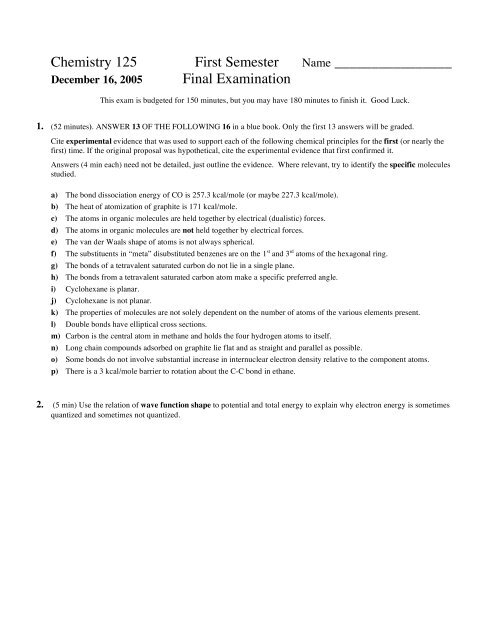
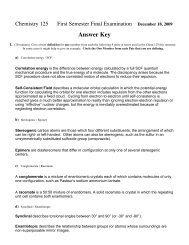
![Review: [untitled] Author(s): Christopher S. Wood ... - Yale University](https://img.yumpu.com/47633680/1/184x260/review-untitled-authors-christopher-s-wood-yale-university.jpg?quality=85)

